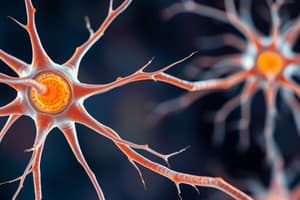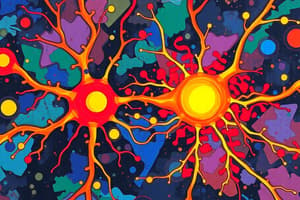Podcast
Questions and Answers
What is the primary function of sensory neurons?
What is the primary function of sensory neurons?
- To cause movement and secretion at the target effector.
- To transmit signals from the CNS to effectors.
- To process information and generate responses within the CNS.
- To detect stimuli and convert them into electrical signals. (correct)
Where are the cell bodies of sensory neurons typically located?
Where are the cell bodies of sensory neurons typically located?
- Within the spinal cord.
- Inside the muscles.
- Outside the CNS in sensory ganglia. (correct)
- Within the brain.
Which of the following is NOT a type of signal detected by sensory receptors?
Which of the following is NOT a type of signal detected by sensory receptors?
- Chemicals.
- Touch.
- Gravity. (correct)
- Light.
What best describes the function of receptors?
What best describes the function of receptors?
Which of the following best describes the central nervous system (CNS)?
Which of the following best describes the central nervous system (CNS)?
What is the primary role of motor neurons?
What is the primary role of motor neurons?
Which structures are considered as effectors?
Which structures are considered as effectors?
What characteristic distinguishes motor neurons from sensory neurons?
What characteristic distinguishes motor neurons from sensory neurons?
Flashcards
Sensory Neurons
Sensory Neurons
These neurons transmit information from sensory receptors to the central nervous system (CNS). They convert sensory stimuli into electrical signals for processing.
Receptors
Receptors
Specialized cells that detect specific stimuli in the environment. They convert various forms of energy into electrical signals.
Central Nervous System (CNS)
Central Nervous System (CNS)
The brain and spinal cord, responsible for processing sensory information, integrating it with other information, and generating appropriate responses.
Motor Neurons
Motor Neurons
Signup and view all the flashcards
Effectors
Effectors
Signup and view all the flashcards
Photoreceptors
Photoreceptors
Signup and view all the flashcards
Mechanoreceptors
Mechanoreceptors
Signup and view all the flashcards
Chemoreceptors
Chemoreceptors
Signup and view all the flashcards
Study Notes
Sensory Neurons
- Sensory neurons transmit information from sensory receptors to the central nervous system (CNS).
- Sensory receptors detect stimuli such as light, sound, touch, temperature, and pain.
- Sensory neurons convert sensory stimuli into electrical signals the CNS can process.
- These electrical signals travel along the axon of the sensory neuron to the CNS.
- Sensory neurons are often unipolar or bipolar, with cell bodies outside the CNS in sensory ganglia.
- Various types of sensory receptors exist, each specialized for detecting a specific stimulus.
Receptors
- Receptors are specialized cells detecting specific stimuli in the environment.
- They initiate the sensory pathway, converting energy (light, sound, touch) into electrical signals.
- Different receptors respond to specific stimuli (photoreceptors for light, mechanoreceptors for touch/pressure, chemoreceptors for chemicals).
- Receptors can be specialized cells or specialized parts of neurons.
- Receptors exhibit adaptation, decreasing response to sustained stimuli over time.
Central Nervous System
- The central nervous system (CNS) comprises the brain and spinal cord.
- The CNS receives sensory information from sensory neurons.
- The CNS processes this information, integrates it with other information, and generates appropriate responses.
Motor Neurons
- Motor neurons transmit signals from the CNS to effectors (muscles and glands).
- Signals from the CNS travel down the motor neuron's axon to the effector.
- Motor neurons control voluntary and involuntary actions.
- Motor neurons are multipolar, with cell bodies in the CNS and axons extending to effectors.
- Motor neuron signals cause effectors to perform specific actions.
Effectors
- Effectors are muscles and glands.
- Muscles contract in response to motor neuron signals, producing movement.
- Glands secrete hormones or other substances in response to motor neuron signals.
- Effectors carry out responses dictated by the CNS after processing sensory information.
- A given effector typically only performs one type of response to a given stimulus; however, combining multiple inputs to different effectors can result in a specific body action or set of actions.
Studying That Suits You
Use AI to generate personalized quizzes and flashcards to suit your learning preferences.




